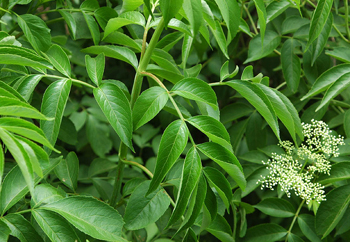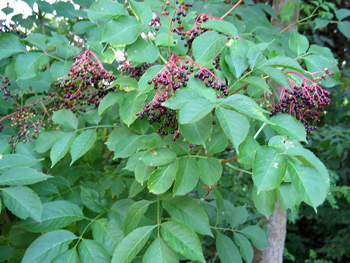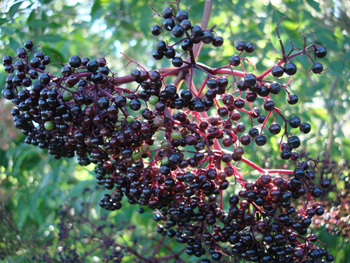Contents:
Common Names | Parts Usually Used | Plant(s) & Culture | Where Found | Medicinal Properties | Biochemical Information
Legends, Myths and Stories | Uses | Formulas or Dosages | Nutrient Content | How Sold | Warning | Resource Links | Bibliography
Scientific Names

- Sambucus canadensis L.
- Sambucus canadensis nigra
- Caprifoliaceae
- Honeysuckle family
Common Names
- American elder
- Black elder
- Common elder
- Elderberry
- Elderberry tree
- Elder flowers
- Rob elder
- Sambucus
- Sweet elder
Parts Usually Used
Root, inner bark, leaf buds, berries, leaves, flowers
Back to Top
Description of Plant(s) and Culture

Elderberry is a native American shrub, growing 5-12 feet tall; the stems with white pith, are covered with rough, yellowish-gray bark and bear opposite, compound, pinnate leaves with 5-11 elliptical, lance-ovate, serrate leaflets. Numerous small, white flowers appear in flat, umbrella-like clusters or cymes from May to July. The fruit is a dark purplish black berry; July to September. Easily propagated by the suckers that it freely produces. Partial shade. The odor is faintly sweet, aromatic; taste is slightly bitter.
Other varieties: Black elder (S. nigra); Red elder (S. racemosa), Paiute Indian name “Koono gibu” and Shoshone Indian name “Duhiembuh” is the red elderberry; Elderberry (S. glauca), Paiute Indian name “Hubu,” is the blue elderberry; Dwarf elder (S. ebulus), also called dead-wort and wall-wort.
Back to Top
Where Found
Grows in damp areas, rich soils, and waste places, thickets, along trails, and roadsides, in fields, fences and ditches, particularly in the central and eastern states of the United States. Nova Scotia to Georgia; Texas to Manitoba.
Back to Top
Medicinal Properties
Aged bark: emetic (in large doses), cathartic (topical-emollient)
Flowers: diaphoretic, diuretic, expectorant, febrifuge, exanthematous, alterative, emollient, discutient, rubrifacient, stimulant (topical-anti-inflammatory)
Berries: antiviral, laxative, diuretic, promotes sweating
Back to Top
Biochemical Information
An unknown bitter principle, saponins, hydrocyanic acid and sambuline.
Back to Top
Legends, Myths and Stories

Native Americans called elder the “tree of music” and made flutes from branches cut in spring and dried with the leaves on. Large shoots were used for arrow shafts.
The ancient Germans believed it to be the dwelling of Mother Hulda, the protectress of house and home. On virtually every German farm an elderberry shrub could be found near the house or the stalls or in the garden. There is legitimate reason to assume that elderberry was used for medicinal purposes even in prehistoric times.
In ancient times, elder trees were believed to have special mystical properties and it was considered good luck to plant a tree near the home to protect against disease and evil spirits. There is one planted outside of Westminster Abbey for this purpose.
The Legend of the Elder, according to Earl Mindell’s Herb Bible, states: “The elder tree was reputed to be the favorite tree of witches, who supposedly resided in its branches. In the Middle Ages, nearly everyone knew that cutting down an elder tree would incur the wrath of the witches who called it home. There were many tales of angry witches taking vengeance on babies whose unwitting parents put them in a cradle of elder wood.”
Judas is said to have hung himself from this type of tree. One of the oldest legends held that it was the elder wood that was used for making the Cross of Calvary. Sorrow and death was believed to hover over this plant, even back in the Dark Ages when the barbarians poured out of the forests fringing the edge of civilization.
If an elder bush flowers after being trimmed in the shape of a cross and planted over a new grave, it was believed the soul of the person lying beneath was happy. Green branches were buried with the corpse to protect it from witches and evil spirits. The drivers of hearses even carried whips made of elder wood.
It was believed that a child would stop growing if whipped with an elder stick. The sticks were believed to kill serpents and drive off robbers.
A very old legend proclaimed that “he who stood under an elder tree on Midsummer Eve would see the King of Fairyland ride by attended by all his retinue.”
Dried flowers used to add a delicate flavor to some Moselle wines. Fresh or dried berries used to make factitious port wine, and to adulterate that beverage.
Culpeper states “I know no wonders the root will do.”
Back to Top
Uses
A tea made from the root acts as a diuretic and a hydragogue cathartic. Some Native Americans used root-bark tea for headache, coughs, mucous congestion, colds, influenza, neuralgia, fever, and to promote labor in childbirth. An infusion of leaves and flowers or a decoction of bark serves as an antiseptic wash for skin problems, age spots, removes freckles, wounds, gout, and inflammations. Flower tea taken warm is said to stimulate and to induce sweating; it can be taken for headaches due to colds, blood purifier, and for rheumatism. Taken cold, it has diuretic properties. Dried seeds are used for weight reduction. An infusion of the leaf buds is strongly purgative. Fresh berry juice, evaporated into a syrup, is moderately purgative. It also makes a good ointment for burns when mixed with lard or a creamy base. Externally used for rashes and minor skin problems. The ointment may be used to relieve dry skin. The dried berries can be made into a tea useful for diarrhea and cholera.
An infusion of elder flowers is a well-known eye-wash in Europe.
An infusion made of elder flowers, peppermint or yarrow herb is much used in Europe taken hot as a night cap when colds threaten. The flowers are steeped in boiling water only a few seconds then strained off. The tea may be sweetened with honey or taken plain. A tea of the flowers alone was a favorite recipe for jangled nerves taken at night. A pinch of elder flowers added to ordinary tea gives the tea a delicious flavor.
Bruised leaves will keep away flies, as a spray, elder will keep caterpillars from eating plants; the spray is also good for mildew.
Both flowers and berries are made into wines. Cooked berries can be used in jams and pies.
Back to Top
Formulas or Dosages
Infusion: use 1 tsp. plant parts with 1 cup water.
Tincture: take 20-40 drops in water, 3-4 times a day.
A liquid made of elderberry juice boiled together with crabapple and a little sugar to form a syrup is an old Gypsy remedy for cough and bronchial infections, but store-bought elderberry tea with honey added will also do the trick.
Back to Top
Nutrient Content
Good source of vitamins A, B, and C.
Back to Top
How Sold
Teas, wines, fruits and salves
Back to Top
Warning
Bark, root, leaves, and unripe berries are toxic, said to cause cyanide poisoning, severe diarrhea. Flowers not thought to be toxic; eaten in pancakes and fritters. Only bark that has been aged for a year or more should be used or cyanide poisoning may result. The Western species are more toxic.
All parts of the fresh plant can cause poisoning. Children have been poisoned by chewing or sucking on the bark. Cooked berries are safe and are commonly used in pies and jam.
Commercially obtained preparations (teas, salves) are perfectly safe.
Do not use the bark in pregnancy; it is very strongly purgative.
Back to Top
Resource Links
Bibliography
![]() Back to Eden
Back to Eden, by Jethro Kloss; Back to Eden Publishing Co., Loma Linda, CA 92354, Original copyright 1939, revised edition 1994
![]() The Complete Medicinal Herbal
The Complete Medicinal Herbal, by Penelope Ody, Dorling Kindersley, Inc, 232 Madison Avenue, New York, NY 10016, First American Edition, copyright 1993
![]() Culpeper’s Complete Herbal & English Physician: Updated With 117 Modern Herbs
Culpeper’s Complete Herbal & English Physician: Updated With 117 Modern Herbs, by Nicholas Culpeper, Meyerbooks, publisher, PO Box 427, Glenwood, Illinois 60425, 1990, (reprint of 1814)
![]() The Herb Book
The Herb Book, by John Lust, Bantam Books, 666 Fifth Avenue, New York, NY. copyright 1974.
![]() Eastern/Central Medicinal Plants
Eastern/Central Medicinal Plants, by Steven Foster and James A. Duke., Houghton Mifflin Company, 215 Park Avenue South, New York, NY 10000
![]() The Nature Doctor: A Manual of Traditional and Complementary Medicine
The Nature Doctor: A Manual of Traditional and Complementary Medicine, by Dr. H.C.A. Vogel; Keats Publishing, Inc., 27 Pine Street (Box 876) New Canaan, CT. 06840-0876. Copyright Verlag A. Vogel, Teufen (AR) Switzerland 1952, 1991
![]() Indian Uses of Native Plants
Indian Uses of Native Plants, by Edith Van Allen Murphey, Meyerbooks, publisher, PO Box 427, Glenwood, Illinois 60425, copyright 1958, print 1990
 Old Ways Rediscovered
Old Ways Rediscovered, by Clarence Meyer, Meyerbooks, publisher, PO Box 427, Glenwood, Illinois 60425, published from 1954, print 1988
![]() Chinese Medicinal Herbs
Chinese Medicinal Herbs, compiled by Shih-Chen Li, Georgetown Press, San Francisco, California, 1973.
![]() The Herbalist Almanac
The Herbalist Almanac, by Clarence Meyer, Meyerbooks, publisher, PO Box 427, Glenwood, Illinois 60425, copyright 1988, fifth printing, 1994
 Earl Mindell’s Herb Bible
Earl Mindell’s Herb Bible, by Earl Mindell, R.Ph., Ph.D., Simon & Schuster/Fireside, Rockefeller Center 1230 Avenue of the Americas, New York, New York 10020
![]() Indian Herbalogy of North America
Indian Herbalogy of North America, by Alma R. Hutchens, Shambala Publications, Inc., Horticultural Hall, 300 Massachusetts Avenue, Boston, Massachusetts 02115, 1973
Herbal Gardening, compiled by The Robison York State Herb Garden, Cornell Plantations, Matthaei Botanical Gardens of the University of Michigan, University of California Botanical Garden, Berkeley., Pantheon Books, Knopf Publishing Group, New York, 1994, first edition
 The Magic of Herbs
The Magic of Herbs, by David Conway, published by Jonathan Cape, Thirty Bedford Square, London, England. (Out of print)
![]() Planetary Herbology
Planetary Herbology, by Michael Tierra, C.A., N.D., O.M.D., Lotus Press, PO Box 325, Twin Lakes. WI 53181., Copyright 1988, published 1992
![]() American Folk Medicine
American Folk Medicine, by Clarence Meyer, Meyerbooks, publisher, PO Box 427, Glenwood, Illinois 60425, 1973
![]() The Yoga of Herbs: An Ayurvedic Guide to Herbal Medicine
The Yoga of Herbs: An Ayurvedic Guide to Herbal Medicine, by Dr. David Frawley & Dr. Vasant Lad, Lotus Press, Twin Lakes, Wisconsin, Second edition, 1988.
![]() Webster’s New World Dictionary
Webster’s New World Dictionary, Third College Edition, Victoria Neufeldt, Editor in Chief, New World Dictionaries: A Division of Simon & Schuster, Inc., 15 Columbus Circle, New York, NY 10023
 An Instant Guide to Medicinal Plants
An Instant Guide to Medicinal Plants, by Pamela Forey and Ruth Lindsay, Crescent Books (January 27, 1992).
 The Healing Plants
The Healing Plants, by Mannfried Pahlow, Barron’s Educational Series, Inc. 250 Wireless Blvd., Hauppauge, NY 11788, 1992
 The Rodale Herb Book: How to Use, Grow, and Buy Nature’s Miracle Plants (An Organic gardening and farming book)
The Rodale Herb Book: How to Use, Grow, and Buy Nature’s Miracle Plants (An Organic gardening and farming book), edited by William H. Hylton, Rodale Press, Inc. Emmaus, PA, 18049., 1974
